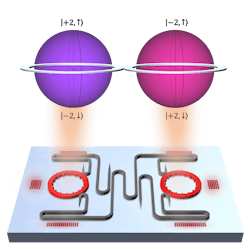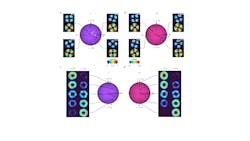Quantum communications get added dimensions, thanks to microlaser chip
A team of researchers, led by Professor Liang Feng’s Lab at the University of Pennsylvania (Philadelphia, PA), designed and built a hyperdimensional microlaser to emit photons possessing any states within a four-level quantum system consisting of spin angular momentum and orbital angular momentum with very high fidelity.
This work is a huge leap forward because the team’s microlaser chip can be used as a source in free-space quantum key distribution (QKD) and coherent classical communications, particularly for satellite-to-Earth communications or tower-to-tower communications (see video).
Classical information theory based on binary digits (bits) forms the backbone of modern information processing and communication systems. “Inspired by the achievement in classical information, quantum information processing today is mainly based on quantum bits (qubits), which can process a value of 0 or 1 at the same time—known as ‘superposition’ in quantum mechanics,” says Feng.
As the ability to control different two-level quantum systems developed, several quantum protocols and algorithms were proposed and deployed, which enabled secure communications and exponential computation speedups.
Looking beyond qubits to qudits
But qubits may not be the ideal choice to encode quantum information, because quantum system qudits—a quantum bit in a state of superposition greater than two levels—offer advantages for information processing.
“In quantum communications with photons, for example, systems using qubits can only transmit 1 bit/photon with a perfect quantum channel,” explains Feng. “But with N-level qudits, Log2 (N) bits/photon of information can be transmitted. It’s been proven that communication systems built on qudits are more robust and can pave the way for a futuristic mature quantum communications network.”
Multiple attempts are already being made to control high-dimensional quantum systems. “In a photonic system, large-scale on-chip photonic processors are being developed for both high-dimensional classical and quantum integrated information processing, where the information is mainly encoded in multiple ‘paths,’ or which waveguide the photon is in,” says Haoqi Zhao, a Ph.D. student working with Feng. “This encoding method is appropriate for on-chip information processing, but it could be difficult to use for long-distance free-space communications.”
But the angular momentums of photons, including their spin angular momentum, looks promising for long-distance high-dimensional communications—especially for satellite-to-Earth communications and tower-to-tower communications (see Fig. 1).
To date, “several experiments have tested high-dimensional information transmission with angular momentums of light, but all of them used multiple bulky free-space optical components, including waveplates, polarizers, phase plates, and spatial light modulators to encode information, which limits the development of angular momentum-based communication systems to a large extent,” says Zhao.
Emission and manipulation of the high-dimensional angular momentum states of photons must be developed to move this field forward. “Our previous works showed integrated lasers emitting photons can carry well-defined angular momentum,” Zhao adds. “So we set out to develop a lasing system to emit photons whose state can be arbitrarily maneuvered within a 4-dimensional (4D) angular momentum space.”
Hyperdimensional microlaser chip design
The team’s microlaser chip consists of two same-sized micro-ring resonators on a III-V semiconductor platform (see Fig. 2). Each ring resonator can host two optical modes: a clockwise propagating mode and a counterclockwise propagating mode.“These four modes can be transferred to free-space modes carrying different spin angular momentum and orbital angular momentum with designed scatters—spanning a 4D system,” points out Zhao.
This four-level system can be represented by three coupled spheres, with six free parameters to control (see Fig. 3). Each sphere possesses two free parameters akin to longitude and latitude on Earth.“Our goal is to control these six parameters,” explains Zhao. “So we fabricated optical waveguides to guide the light from one ring resonator to the other. When light is guided inside the waveguide, power can be either amplified or attenuated, controlled by the external optical pump. The temperature of the waveguide can also be changed, which can change the phase delay of the light.”
The team demonstrated their method’s ability to control all six parameters and emit any states within this 4D space. This means the microlaser can be used as a 4D qudits distribution source, as well as an optical source in coherent classical communications.
One of the biggest challenges for the team while developing the microlaser was using a linear model to describe the system—a microlaser is a nonlinear system and ultimately needs a nonlinear model to describe it. “While the linear model can help us design the microlaser system, it can’t predict all of its behaviors,” says Zhao. “Surprisingly, our microlaser successfully emits all the states within the 4D angular momentum space with high fidelity—outperforming the linear model.”
Before the team’s work, nearly all methods to generate optical states within an angular momentum space required use of extremely bulky tabletop optical systems that are complex and need optical alignment.
Now, any states within a 4D angular momentum space can be easily generated by controlling the microlaser chip’s optical pump.
“Its scalability and compactness make it easy to deploy on communication satellites or towers, and it provides a possible solution in satellite-to-Earth communications and tower-to-tower communications—paving the way toward next-generation high-capacity, noise-resilient communications technologies,” says Zhao.
Microlaser for quantum communications
The goal of quantum communications is to transmit information in a highly secure manner. Usually, the sender (Alice) encodes the secret key into some quantum states. She then sends these quantum states to the receiver (Bob), who will measure these states in sequence. Then, Alice and Bob communicate with each other about how they prepare and measure the quantum states using a classical communications channel.
“Based on this information, Alice and Bob can share a sequence of a common secret key,” says Zhao. “Finally, they can compare some part of the secret key, and anyone who wiretaps the information within the quantum channel will be noticed by the users during this process.” Security of their communications is guaranteed.
“With a ‘decoy state protocol,’ when our microlaser is being attenuated to the single-photon level, it can be used as a source in QKD,” says Zhao. “Moreover, our laser can emit 4D qudits and transmit 2 bits/photon—doubling the channel capacity compared with qubits. Using 4D qudits in QKD can also allow more disturbance within the quantum channel—increasing the robustness of the communications system.”
Next steps
The team is now focusing on three key areas to improve their microlaser system. Their first step is to integrate more on-chip ring resonators and waveguides to expand the system’s dimensionality.
Second, they want to develop an electrical-pumped microlaser—their current device is optically pumped—to control all parameters in a fast, electrical way. “This step is critical to move our device toward real industrial applications,” says Zhao.
And the third step is to develop a mature quantum communications system based on their device. “It’ll consist of multiple hardware parts—including the microlaser as a source and the integrated receiver setup,” Zhao adds. “We also want to develop the software parts based on the hardware parts to do the real quantum communication, and then we’ll evaluate the robustness and bit rates of our system.”
FURTHER READING
Z. Zhang et al., Nature, 612, 246–251 (2022); https://doi.org/10.1038/s41586-022-05339-z.

Sally Cole Johnson | Editor in Chief
Sally Cole Johnson, Laser Focus World’s editor in chief, is a science and technology journalist who specializes in physics and semiconductors. She wrote for the American Institute of Physics for more than 15 years, complexity for the Santa Fe Institute, and theoretical physics and neuroscience for the Kavli Foundation.


